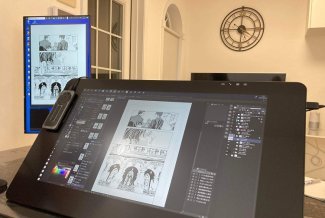Taking inspiration from the philosophy of US urbanist Jane Jacobs, Adriana Linde organises urban walks in Malaga, Spain, inviting people to rediscover the city, by walking its streets in a conscious way, and to join the ‘sidewalk ballet’.
Little by little, they disappeared from the streets – no alarm was raised, so subtle was the shift. They were confined to enclosed spaces, held captive for their own safety, all trace of them slowly erased from the common landscape. Think back, try to remember, how long has it been since you last saw a child playing on the street?
“Children have lost the city,” warned Italian educational psychologist Francesco Tonucci, in the 1990s, when research into children’s mobility and autonomy began showing evidence of this gradual retreat. Overprotectiveness, the dictatorship of the automobile, the design and the pace of our cities robbed them of their right to walk freely, to walk alone. “There are studies showing that children have lost metres of movement in their everyday space,” says social psychologist Ana Paricio. “And they are not the only ones.”
The streets belong to everyone, they say, but the children of today only see them from a distance, from the window of the car that takes them to school or from the safety of the playgrounds under permanent surveillance.
The streets belong to everyone, yet there are older people who live confined to their homes because their neighbourhoods have become too much of a physical challenge, people with reduced mobility who cannot go to public spaces because they are not accessible, women who will not take certain streets after a certain time because they are not lit, because they do not feel safe. Do the streets belong to everyone?
Clearly not, says Paricio. There is a basic error, a flaw in the foundation that dates back 50 years, to when those same streets were designed for a single purpose – work – and a single type of person – the predominant workforce back then: “middle-aged, white men, in good health and with their own car”. That was the spec. The city’s key mission was to facilitate the office employee’s journey to work – widening the avenues and narrowing the pavements – even though it meant making it impracticable for everyone else.
That old design has much to do with many of the major challenges of our day, the people on and off the streets, the loneliness, the inequalities, the low quality of life, the violence. Improving the anatomy of cities – making them kinder and more inclusive – has become one of the United Nations’ Sustainable Development Goals and the obsession of a new generation of architects and urban designers, now committed to rebuilding streets that work for people, not against them.
Kind cities
More than half the world’s population is currently living in cities, a proportion set to reach 70 per cent by the year 2050, when one in six people will be over 65 – more than enough reason to redesign our streets to fit everyone’s needs.
“The cities we live in today are hostile environments for people who are ageing,” says Elena del Barrio, a gerontologist at the Matia Foundation and Institute. There are insufficient lifts, insufficient places to sit and insufficient public toilets. We need wider pavements, slower traffic lights, spaces where we can walk, meet up and feel less lonely. “All this limits peoples’ access to a whole range of places, to the point that they confine themselves to their homes.”
If not properly designed, as the World Health Organization warns, the city can turn into a disabling environment, and not only due to the architectural barriers. As Elena del Barrio explains, “It’s also very important that we live as a community, that we know our neighbours and that we look after each other.”
Understanding the importance of community and neighbourhood networks as key aspects of life in the city is part of the approach taken in urban planning with a feminist perspective. The idea is to create streets designed to work for us and not just to get us to work earlier.
The idea is to create streets that make all the little aspects of everyday life easier, tasks such as shopping, health care, looking after children and the elderly, responsibilities that mainly fall on women.
“We need to ensure that cities offer the time and the space needed to make everything simpler and more pleasant. They should provide us with access to nearby facilities, the ability to get around on foot or by public transport. Traffic needs to be slowed down, pavements should be safe and accessible and school exits protected,” explains Paricio, who is also the author of the Manual de urbanismo y vida cotidiana (Guide to Urban Planning for Everyday Life) published by the Barcelona City Council.
She insists that these are small but pivotal changes, as they make the difference between a liveable city and a frenetic, productive city.
Lively cities
A city without children is “a sick city”, said Francesco Tonucci, in the 1990s. But 30 years before him, a woman from the United States had already given a detailed diagnosis of the same silent disease.
Her name was Jane Jacobs. Although not an architect, she was the first to point, back in 1961, to the ills of orthodox urban planning centred on offices rather than people. Her book – now revered by new generations of architects – was entitled The Death and Life of Great American Cities, because it was warning against precisely that: lifeless streets, walkways without walkers, urban landscapes turned into miracles of monotony, neighbourhoods carved up and labelled according to their price and their function.
For Jacobs, the only way to save a city’s life was to restore what she termed the “sidewalk ballet”, that continuous dance of different people coming and going, moving, chatting, playing in the public space. Streets need life, the activist argued, because lively streets bring people together, and that makes them safer.
“She said that neighbourhoods had to be lively. That is why the small businesses where people shop on a daily basis are so important. They bring life,” says Adriana Linde, one of Jacobs’ many followers around the world today involved in associations, such as Jane’s Walk, that organise conscious walks, inviting people to rediscover cities and take part in the ‘sidewalk ballet’.
“The streets have to be frequented. When you do so, you give them a symbolic value, you take ownership of them. I always say, my home has three rooms, 18 streets and 20 hectares, which is the size of my neighbourhood.”
Taking ownership, as Linde says, inevitably means going against the tide, breaking down the barrier that separates the public and the private space, that impenetrable border that has turned our streets into corridors interconnecting a hive of loneliness.
Cities for all
“There are various stages in the history of public space: from the importance it had in Greek times, with the agora as the central public space, to well into the 20th century, when its erosion began,” says Jon Aguirre Such, an architect at the urban planning office Paisaje Transversal.
The deterioration in our shared space is best illustrated by the so-called hard plazas, spaces without proper seating, without vegetation, spaces that do not encourage “lingering or socialising”, adds Aguirre, “spaces only geared towards consumption”. All of these barren places, these temples of indifference where no one lingers, have something in common: they were designed without first listening to those who were going to use them.
“Urban planning is done on such a large scale that we forget about people. But, ultimately, it is those who tread a city’s pavements who know the city best,” explains consultant and doctor in architecture Mar Melgarejo, who dedicated months of research into how residents used the main squares and public spaces in Cartagena in Spain to reach a curious conclusion. “Our research highlighted the paradox that spaces designed by renowned architects, who had been awarded for their work, were always empty. People didn’t use them because they didn’t meet their needs.”
The battle against the hostile city should not only be waged for the people but with the people. This is the philosophy behind new urban design movements such as placemaking.
“The idea is to put people at the centre of design projects, promoting dialogue to examine problems and design solutions for the construction of more inclusive, lively and active spaces,” says Aguirre Such.
There are already a number of innovative participatory projects in which older people, women and children are invited to tell – rather than being told by – urban planners what type of neighbourhood they want to live in. “These processes also have clear therapeutic benefits. People come together, see that they are part of something, interact with their neighbours. New emotional bonds are also formed with the space. And when people feel that a place is theirs, they take better care of it.”
If Jane Jacobs were here today, she would probably be surprised to see how current many of her ideas still are to this day – although much more present, it has to be said, in debates than plans. “Urban planning moves at a snail’s pace,” admits Melgarejo. It needs a push from mobilised citizens, but “we are not yet accustomed to thinking that the public space also belongs to us”.










